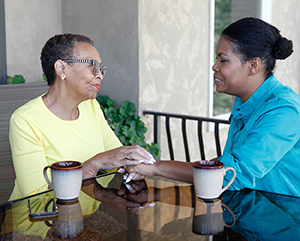Depression and Suicide in Older Adults
Nearly 2 million older adults in the U.S. have some type of depression. Some of them even take their own lives. Yet depression among older adults is often ignored. Learning about the warning signs of depression may help spare a loved one needless pain. You may also save a life.
What is depression?
Depression is a common and serious illness. It affects the way you think and feel. It is not a normal part of aging. It is not a sign of weakness, a character flaw, or something you can "snap out of." Most people with depression need treatment to get better. The most common symptom is a feeling of deep sadness. People who are depressed also may seem tired and listless. And nothing seems to give them pleasure. It’s normal to grieve or be sad sometimes. But sadness lessens or passes with time. Depression rarely goes away or improves on its own. Other symptoms of depression are:
-
Sleeping more or less than normal
-
Eating more or less than normal
-
Having headaches, stomachaches, or other pains that don’t go away
-
Feeling nervous, “empty,” or worthless
-
Crying a lot
-
Thinking or talking about suicide or death
-
Loss of interest in activities previously enjoyed
-
Social isolation
-
Feeling confused or forgetful
What causes it?
The causes of depression aren’t fully known. But it is thought to result from a complex blend of these factors:
-
Biochemistry. Certain chemicals in the brain play a role.
-
Genes. Depression does run in families.
-
Life stress. Life stresses can also trigger depression in some people. Older adults often face many stressors. These may include isolation, the death of friends or a spouse, health problems, and financial concerns.
-
Chronic health conditions. This includes diabetes, heart disease, or cancer. These can cause symptoms of depression. Medicine side effects can cause changes in thoughts and behaviors.
Giving support

Depressed people often may not want to ask for help. When they do, they may be ignored. Or they may get the wrong treatment. You can help by showing parents and older friends love and support. If they seem depressed, don’t lecture the person or ignore the symptoms. Don't discount the symptoms as a “normal” part of aging. They are not. Get involved, listen, and show interest and support.
Help them understand that depression is a treatable illness. Tell them you can help them find the right treatment. Offer to go to their healthcare provider's appointment with them for support when the symptoms are discussed. With their approval, contact a local mental health center, social service agency, or hospital about services.
Helping at healthcare visits
You can be an advocate for them at healthcare appointments. Many older adults have chronic illnesses. Many of these can cause symptoms of depression. Medicine side effects can change thoughts and behaviors.
You can help make sure that the healthcare provider looks at all of these factors. They should refer your family member or friend to a mental healthcare provider when needed. In some cases, untreated depression can lead to a misdiagnosis. A person may be diagnosed with a brain disorder such as dementia. If the healthcare provider does not take the issue of depression seriously, help your family member or friend find another provider.
Asking about self-harm thoughts
If you think an older person you care about could be suicidal, ask, “Have you thought about suicide?” Most people will tell you the truth. If they say yes, they may already have a plan for how and when they will attempt it. Find out as much as you can. The more detailed the plan, and the easier it is to carry out, the more danger the person is in right now. Tell the person you are there for them and you do not want them to get harmed. Don't wait to get help for the person. Call the person's healthcare provider, local hospital, or emergency services.
Call 988 in a crisis
Never leave the person alone. A person who is actively suicidal needs crisis care right away. They need constant supervision. Never leave the person out of sight. Call 988 Tell the crisis counselor you need help for a person who is thinking about suicide. The counselor will help you get the right level of crisis help. You may be advised to take the person to the nearest emergency room.
The National Suicide Prevention Lifeline is available at 988, or 800-273-TALK (800-273-8255), or www.suicidepreventionlifeline.org. When you call or text 988, you will be connected to trained counselors who are part of the National Suicide Prevention Lifeline network. An online chat option is also available. Lifeline is free and available 24/7.